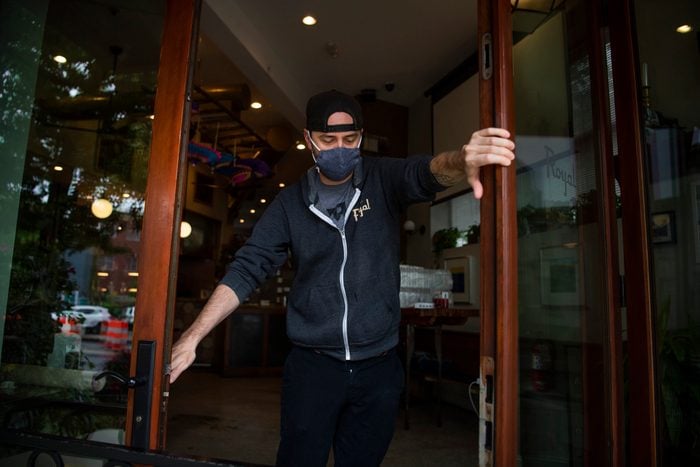
The road map for reopening
Think back to the last time you dined out in a restaurant. If you’re like many Americans, it was probably February or early March. You likely opened the door and made your way to a cozy table, or perhaps you pulled up a stool at a counter or bar. You probably didn’t think twice about diving into the shared chips and salsa or basket of fries (without washing those door-handled hands) and maybe even took a bite off your partner’s or pal’s spoon.
As restaurants begin to reopen in many parts of the country, your experience—and the restaurant’s design, menu, and staff—will look a lot different. Like the response to the virus mitigation strategy and stay-at-home orders, regulations vary by state and sometimes even by city. (Oregon, for example, allowed restaurants to open on May 15 in all parts of the state except Portland and Salem.) Often, these regulations are actually recommendations, and the businesses can decide what they think is best for their establishment, staff, and patrons.
There’s not one specific group or government agency responsible for guiding restaurant safety, especially during pandemics, but the National Restaurant Association (NRA), Centers for Disease Control and Prevention (CDC), and Food & Drug Administration (FDA) have each released blueprints to attempt to coach businesses about how to reopen safely. To help boil it all down, we spoke to restaurant owners, chefs, architects, and food-safety experts to give you a better idea of what might be “in” during this new age of dining out.
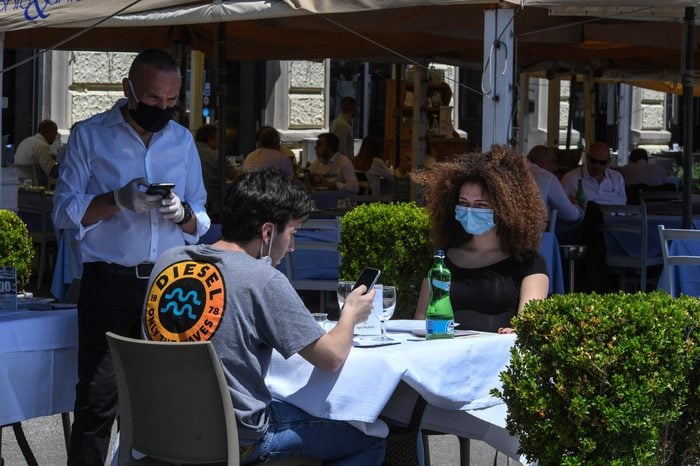
Restaurants will likely embrace technology even more
With new safety rules in place, restaurants will probably rely more heavily on online ordering and reservations at many locations. “In the immediate future, you will see an experience where all elements of interaction are carefully considered in advance,” says Donnie Madia, partner and restaurateur at One Off Hospitality Group in Chicago, which includes restaurants like the Publican, Blackbird, avec, and Pacific Standard Time. “For example, there might be a system in place that would allow you to select your seat at the restaurant prior to your meal, like you would do with a flight or at a movie theater. Restaurants may require you to wait in your car or outside of the restaurant until your table is ready and you are notified by text to avoid congregating.”
Then, once you arrive at your table, you may receive a text with a digital copy of the menu to view—and maybe even order from. “Ordering systems such as Tock are already creating full meal experiences that are purchased and paid for in advance, and these types of platforms are going to be more widely used than ever before,” Madia says.
As the president of Epic Burger in Chicago, Kyle Welch and his team are promoting app downloads with discounts and rewards for certain to-go or delivery purchases. “At Epic Burger, we’re not waiting for things to change—we’re making the best of our situation by controlling what we can and working around what we can’t,” he says. “At this point, there’s no way to know when the dining customer is coming back, so we’re revisioning to accommodate the digital customer.”
And if restaurants didn’t have a strong social media presence before the pandemic, they will probably begin to lean in to those platforms as a way to connect, predicts Hunter Evans, chef and co-owner or Elvie’s in Jackson, Mississippi. This will help diners know how and when the dining room is open, as well as provide information about behind-the-scenes safety strategies, new rules (such as reservations required), and more.
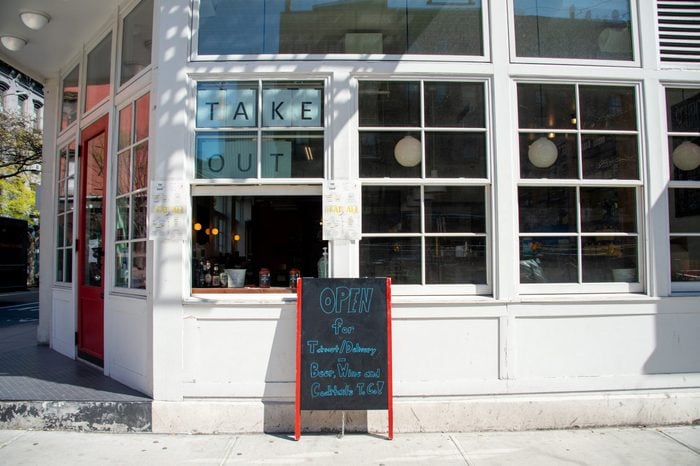
To-go is here to stay
For restaurants that didn’t offer it pre-pandemic but now do, curbside, traditional takeout, and delivery will likely stick around. This will act as an additional way to serve diners—and make money to balance out the fact that restaurants will have fewer seats they can fill.
“Even prior to the pandemic, it was clear that delivery and to-go were on the rise. It’s amazing how restaurants have been able to quickly adapt and pivot their service model to meet the demand for menus that can be shared and enjoyed by people without ever leaving their home,” Madia says. “I think this is something that’s here to stay with restaurants moving forward—whether large or small, full-service or fast-casual. You’re going to see a lot more options outside of just the traditional dine-in model.”
This is an ideal option for people who want to support their favorite local spots but may not feel safe dining in yet, Evans adds.
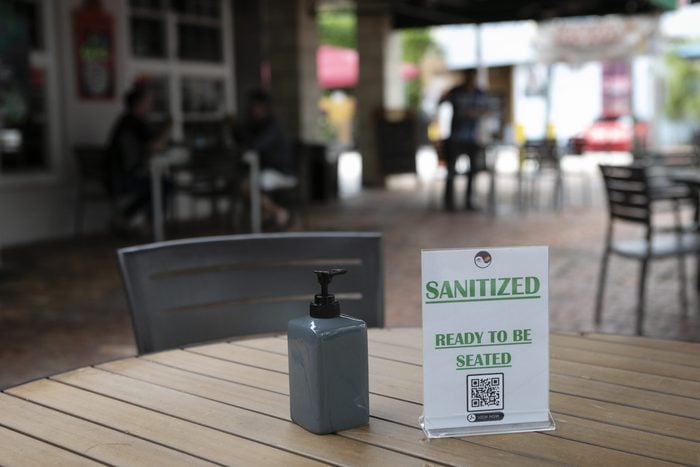
You’ll see lots of hand sanitizer and signs about safety
Hand hygiene has always been vital, but now it’s obviously even more of a big deal. The signs will not only act as a heads-up to diners, but will also hopefully inspire a greater sense of trust. In Iowa, for example, where all restaurants were allowed to open at 50 percent capacity on May 15, the state’s restaurant association teamed up with restaurants to create the “Iowa Hospitality Promise.” Participating establishments can print and post signs about things like tables in use, sanitized tables, and handwashing reminders.
“The success and future of small restaurants will largely depend on public sentiment. I hope people feel safe enough to return to their favorite neighborhood eateries and support small businesses,” says Niccolo Angius, co-owner of Cesarina in San Diego. “I think we’ve built a relationship of trust and virtue with our customers before the pandemic by always doing our best to exceed their expectations. We have always aimed to over-deliver and consistently prove our love and passion with delicious food and hospitality, and this will be a strong foundation for their return to dine-in service.”
No matter where you are, make sure to wash (or sanitize) your hands immediately after touching these 10 things.
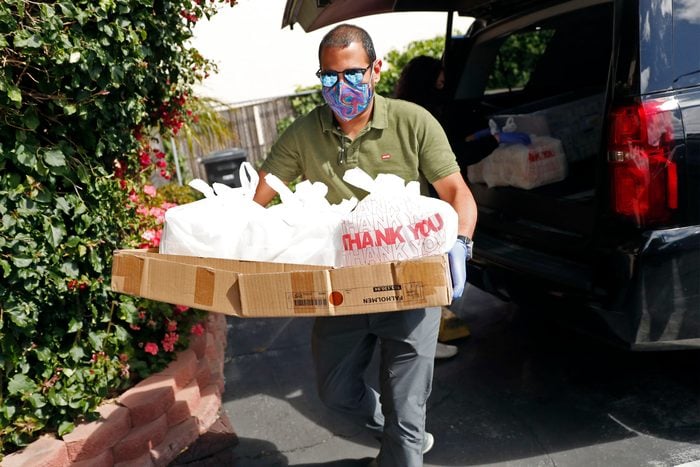
Expect a lot of menu innovation and experimentation
Natalie Seymour, a food safety extension associate at North Carolina State University, is helping to train restaurants in her state as they prepare to reopen dining areas. As a result, she’s been keeping a keen eye on what local establishments are offering—and how. “We’ve seen some pretty innovative ideas around here, from diners selling to-go brunch picnics to ice cream shops selling pints or offering ice cream delivery,” she says.
At Elvie’s, Evans designed takeout menus inspired by a different theme or cuisine each week and began hosting a weekly virtual wine club via Zoom, including bottle and snack pairings from the restaurant. (All current menu and event purchases are available on Tock.)
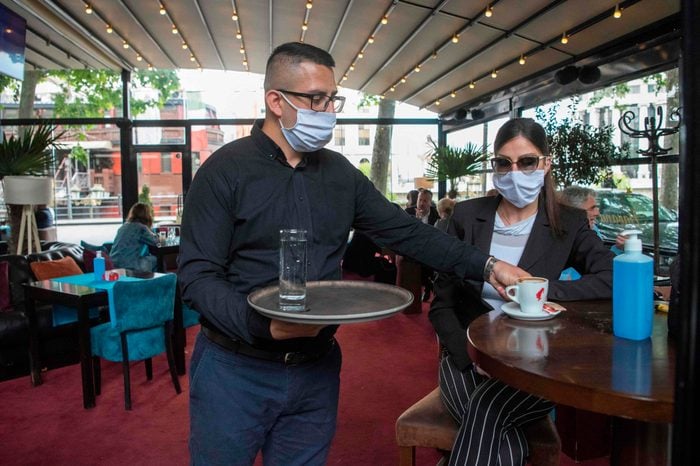
The staff will likely be masked
To protect their teammates and patrons, many servers, hosts, and kitchen employees will be donning cloth face coverings—and some of those coverings may be somewhat stylish. “Regardless of these precautions, I believe it’s important to maintain the charm and warmth that our guests love,” Angius says. “I don’t want the restaurant to resemble a hospital, with servers and hosts that look like nurses or doctors. For that reason, we’re working on custom-made face masks for the staff that will bring a bit of fun and ease to the experience.”
Since diners would need to remove the mask to eat and drink, many restaurants may leave it up to their patrons to decide whether they want to wear their own face coverings or not. Remember: Face masks are mainly worn to prevent the wearer from potentially spreading the virus to others if they happen to be asymptomatic, not to protect the wearer from the germs of those around them.
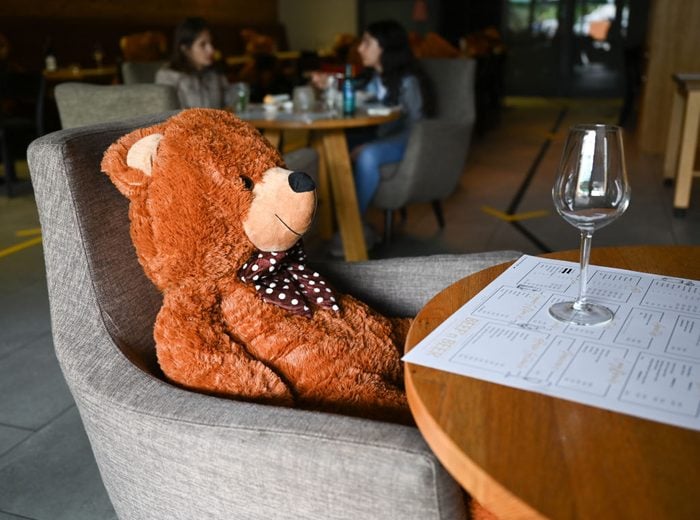
Dining rooms may get a makeover
“There will be more space in between tables for sure, especially at family restaurants or cafés like Elvie’s,” Evans says. “We plan to remove every other table to adhere to social-distancing guidelines.” Some restaurants may simply block off tables, seating guests in every other booth, Seymour explains. Others are getting quite creative, placing mannequins or stuffed animals in empty chairs to make the space feel less sparse. These may ultimately be among the photos that define the era of social distancing.
“Unfortunately, small restaurants may have to become pickup or delivery only if they don’t have enough space for safe distancing,” says Justin Hill, principal at MG2, a global architecture and retail strategy firm based in Seattle. “If their dining window is long enough, reservations might work for a select few to manage seating and flow.”
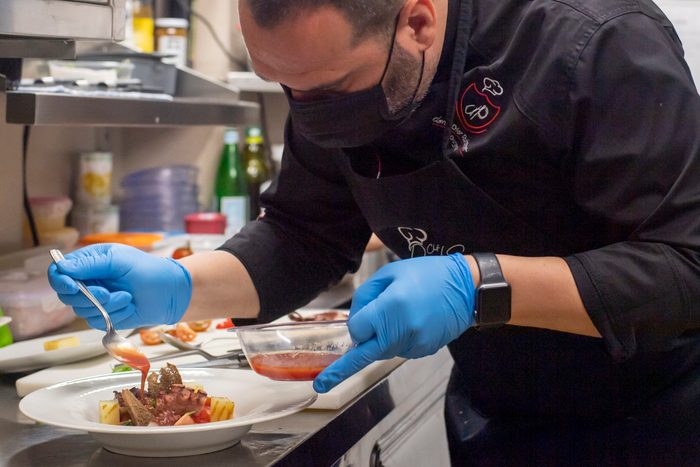
Menus will probably be shorter
Restaurant owners used to be able to predict demand based on trends and order accordingly. But now, most have no idea what to plan for and won’t want to risk over-ordering food that won’t be purchased. So, anticipate a more limited menu for the time being as restaurants try to streamline operations and reduce costs. Many also plan to cross-utilize ingredients (say, putting tomatoes in a salad and on a pizza) to cut down on potential food waste.
“Expect some pricing changes, too,” Hill adds. Why? To cover possible hazard pay for the staff or to make up for overall supply-chain price increases.
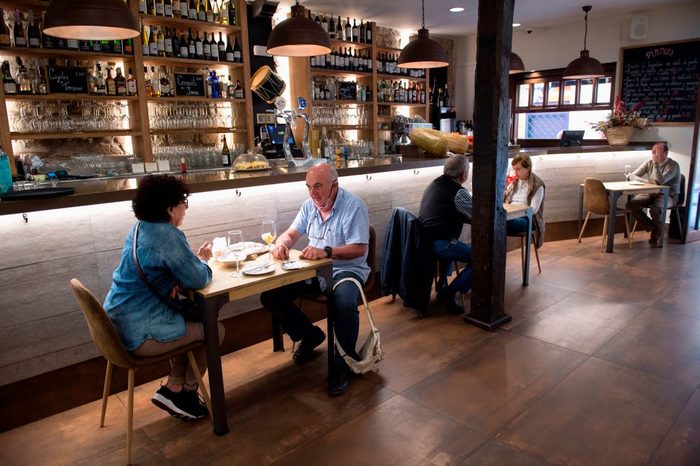
You’ll have less interaction with staff
In addition to those texted or digital menus to reduce touch points on physical menus, “sit-down restaurants might utilize more tabletop ordering and payment kiosks to limit interaction with staff,” Seymour says. In fact, the National Restaurant Association’s reopening guide suggests that restaurants “limit contact between waitstaff and guests.” If you notice that your servers are no longer pointing out every garnish on the plate or asking about your family, know that they are likely reducing chitchat for safety purposes—not because they don’t care. This sort of reduced interaction between staff and guests is also one of the changes you’ll be seeing at hotels in the near future.
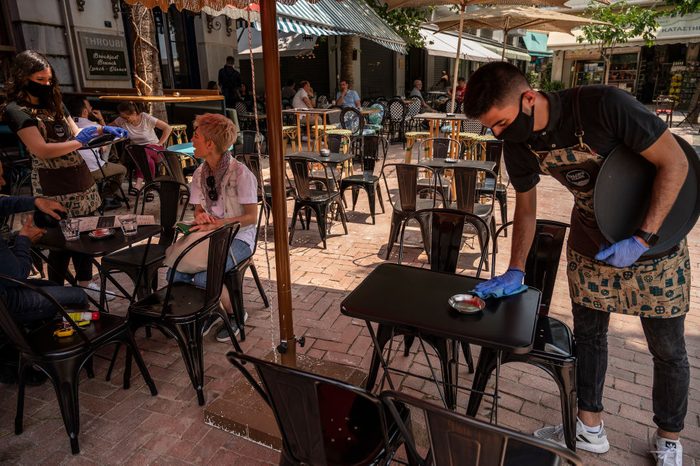
Outdoor dining will be majorly in
Open windows and increased ventilation are two positive ways to reduce risk, according to the CDC, since the air (and potential germs in that air) won’t be recirculated in an enclosed space. In a just-completed study out of China set to be published in the journal Emerging Infectious Diseases, researchers found that respiratory droplets, which are the primary mode of transmission for coronavirus, were likely spread through air-conditioning in one restaurant.
“People in the restaurant industry are working with state and city officials to explore the idea of opening up surrounding parking lots, streets, and loading zones for additional seating just outside the restaurants,” Madia says. “That’s something we’re extremely optimistic about.” These al fresco options can potentially replace some of the interior seats that a restaurant will lose to accommodate safe distancing, Hill notes. “Creative coverings for these areas will [also] pop up,” Hill adds, to protect diners from inclement conditions.
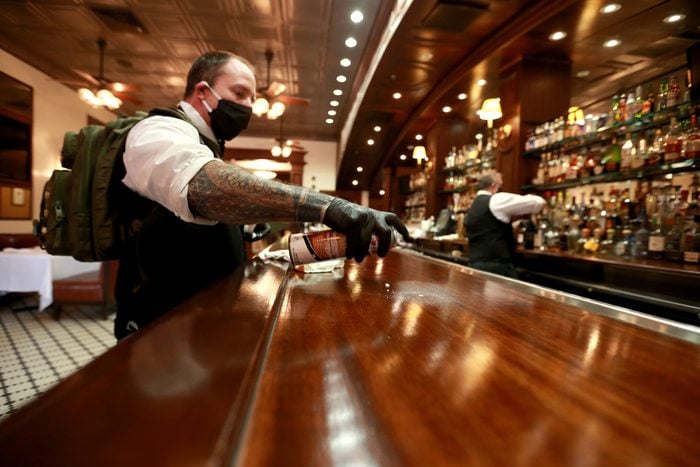
Good hygiene will always be in style
As restrictions relax or once a vaccine is available, some of the more rigorous changes (such as partitions between booths or ground markers in waiting areas) will begin to fade out, Seymour guesses. But hopefully some changes won’t disappear entirely. “I can only hope that the emphasis on health and hygiene, as well as cleaning, sanitizing, and disinfecting, is here to stay, as these practices can be huge for managing food safety and other areas of public health,” Seymour says.
But while restaurant dining is going to be very different for the foreseeable future, most of these changes probably won’t last forever. “I think people are going to crave interaction with others more than ever before, but only when able to safely do so,” Madia says. “After 9/11, our guests wanted to be seated in a way that was a little more intimate. There was more of a social factor built into the dining experience and communal dining became popular. Diners found themselves chatting between tables and creating spirited conversations that resulted in shared celebrations together and even friendships.” Those friendships and celebrations may be even more treasured in the future.
For more on this developing situation, including what else to expect post-lockdown, see our comprehensive Coronavirus Guide.
